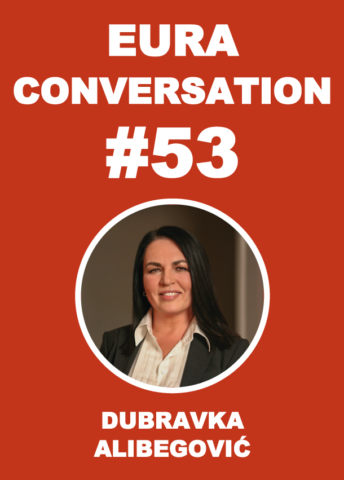
New EURA Working Groups
20/04/2023
EURA 2023 – Late registration is closing soon
27/04/2023Conversation #53
Voluntary merger of municipalities and cities in Croatia
by Dubravka Jurlina Alibegović
The Institute of Economics, Zagreb, Croatia
 In many countries, policymakers are focussing on administrative-territorial reforms in order to improve the effectiveness of local governance. Some have reduced the number of municipalities through mergers. A voluntary merger is when central government provides the legal framework for the merger but leaves local authorities to negotiate and propose new boundaries. This is a "bottom-up" process and emerges based on the interests of local government. A compulsory merger is the other extreme, where central government compels a merger, based on a certain process and time schedule. This process is very much "top-down".
In many countries, policymakers are focussing on administrative-territorial reforms in order to improve the effectiveness of local governance. Some have reduced the number of municipalities through mergers. A voluntary merger is when central government provides the legal framework for the merger but leaves local authorities to negotiate and propose new boundaries. This is a "bottom-up" process and emerges based on the interests of local government. A compulsory merger is the other extreme, where central government compels a merger, based on a certain process and time schedule. This process is very much "top-down".
Croatian academics have highlighted the need to reduce the complex administrative and territorial organization of the country. There are numerous reasons for such reform: in many cases local self-government units are too small in terms of population to provide local public services efficiently and effectively. There are 428 municipalities in Croatia, of which 37 have less than 1,000 inhabitants, and 42 cities have less than 10,000 inhabitants - the minimum for city status. Also, many municipalities lack the organizational and human capacity to perform existing public tasks, nor to take on new ones. Yet there appears to be a reluctance to even consider any form of merger. This may be linked to a perceived loss of identity rather than considering the need for reform. Thus, incentivisation is needed.
Reform procedures aimed at eliminating existing shortages and merging municipalities are political decisions requiring careful preparation and dialogue with all relevant stakeholders. The experiences of countries that have implemented such mergers show voluntary mergers were often only partially implemented, while mandatory mergers were most often comprehensive and radical, but provoked resistance from residents, mayors, or city councillors. To reduce resistance at the local level, countries opted for financial incentives (e.g., Belgium and Estonia), a path Croatia has chosen to follow.
The need to reduce Croatia’s oversized administrative and territorial organization is recognized by politicians. In July 2022, the Croatian Government took a decision on the criteria for allowing financial grants (incentives) for the voluntary functional or actual merger of local governments. It aimed to reduce the fragmentation of the state and to achieve the objective of "Functional and sustainable local self-government", as presented in the National Recovery and Resilience Plan 2021–2026.
Mergers are used to establish a high-quality, efficient, and transparent system of local government to provide services to citizens. This means citizens will have equal opportunities to satisfy their needs and interests, regardless of where they live. Clear targets have been set for 2022 to 2026. At least 20% of local government units, i.e., 111 municipalities and cities, should merge voluntarily, and at least 40% should see voluntary functional mergers.
By adopting the decision, the Government expects the grant to stimulate municipal heads and city mayors to propose plans for actual and/or functional mergers. A grant of HRK 100 million (EUR 13.3 million) is planned for the voluntary mergers of local government and is included in state budget projections for the next two fiscal years.
Voluntary merging of functions of local government will be achieved by implementing agreements on joint performance of self-governing tasks in two ways. The first way is by establishing either a joint civil servant, administrative department, or service to deliver the task. The implementation costs will be subsidised for five years through central government grants. One of the criteria for obtaining a financial grant is the population size of each unit. A municipality with fewer inhabitants will receive a larger grant; those with more than 5,000 inhabitants will not receive anything. This implicitly sets the criterion for the desirable size of a newly merged municipality or city at 5,000 inhabitants.
Financial assistance is also available to establish a joint organization to deliver a particular service e.g., kindergarten, primary school, library, gallery, etc. According to this model, or the second way of voluntary merging of functions, each of the merged municipalities will have the right to co-finance 25% of the cost of the joint organization, up to HRK 500,000 (EUR 66,350). These financial grants are available for up to five years to encourage participating municipalities to develop a sustainable model of financing. At the end of the co-financing period, responsibility for the future costs related to the joint organization will fall entirely on local budgets.
An additional incentive for voluntary functional merger is the retention of the right to a financial grant that was available to them before the merger. However, the Government's decision does not specify which grants that municipalities and cities could access in the long term. It is most likely about a fiscal equalization grant for decentralized functions, and perhaps the continuation of providing compensatory funds to municipalities and cities for loss of revenues.
According to the Government decision, the voluntary actual merger of local government units means merging at least two municipalities or cities. A municipality or a city to which other units have been joined can receive three types of grants from the state budget: (i) one-time grant for the repayment of overdue obligations of the joined municipality or city and settlement of one-off material costs of the merger; (ii) current grants in an annual amount that is twice the amount of fiscal equalization grant of the joined municipality or city in the year before the merger and grant for capital projects of up to HRK 7.5 million (EUR 1 million); (iii) other grants related to the repayment of loan obligations of the merged municipalities or cities, less all repayments up to the date of merger.
A positive feature of the decision relates to local development in the merged municipalities or cities, where a minimum of 50% of current grants must be used for capital projects benefitting residents of the joined municipality or city. Merged municipalities or cities can obtain all three types of grants, but only in cases where municipalities or cities are classified as underdeveloped areas. This is an indirect incentive for underdeveloped municipalities or cities to merge with more developed local communities, but not for more developed or wealthy municipalities.
There was a strict time limit to express interest in any merger. By its end, media sources suggested 11 municipalities and 3 cities had expressed interest in a voluntary functional merger, and no reported interest in voluntary actual mergers. I believe the key obstacle to the voluntary actual merger of municipalities and cities is the negative perception of territorial reform because local officials fear losing their jobs, citizens fear losing their municipal "autonomy" and "identity", and local politicians fear losing voter support. The different financial incentives do not appear to have stimulated interest in either functional or actual mergers, leaving an ineffective and inefficient status quo.
These debates about how to reform local government to make it more effective and accountable are not, of course, limited to Croatia. I welcome learning about efforts taking place in other European countries to reform local government, and I hope that this contribution can stimulate further exchanges on this important topic.







The conventional wisdom points out the benefits of mergers, from an economic-administrative perspective. In what is maybe an overly rationalised view of territorial realities, central governments expect local actors to perceive these benefits and act on this perception (accept compulsory mergers or initiate voluntary ones). Moreover, where central governments are reluctant or unable to trigger compulsory mergers, economic incentives are created to stimulate voluntary mergers. At least in the short term, these incentives are expected to make the economic-administrative benefits even more visible to the local actors. Yet, as the Croatian example suggest, sometimes these incentives do not seem to work. Maybe these economic incentives are simply not sufficient, but there is also at least one alternative explanation.
It might be the case that the policy itself is counterintuitive. If local actors oppose mergers, but do not contest the economic-administrative reasoning behind them, then their concerns clearly rest elsewhere. There might be subjective political or cultural concerns which drive local actors, and which are not a thing of the moment. These concerns need to be addressed by the central government seeking voluntary mergers to obtain its desired response from the local actors. Just how powerful these local political and cultural concerns are can be exemplified by looking at the experience of Romania. In the early 2000s, 30 years after a major compulsory amalgamation reform was implemented by the Communist regime, a significant de-amalgamation reform has occurred. An examination of the motives behind local initiatives to de-amalgamate after such a long time pointed out political and cultural explanations specifically linked to “the way things were” before amalgamation. It might also be that in newer democracies (more fragile democratic contexts) local political and cultural concerns are even more powerful than in more established democracies.
Whether it is a decision for a voluntary or a mandatory merger of small municipalities with insufficient capacity, it is always a political decision, and its implementation requires the consent of all political options, positions, and opposition at the central and local level.
There is not a single example of a country where the process of consolidation of municipalities was completed successfully within the planned period. That is why some countries (Slovenia, Switzerland) promote cooperation between municipalities in which joint administrative bodies are established to perform inspection and legal activities, ICT and accounting services, cooperation for the provision of local public services in the field of social protection or activities that ensure local economic development.